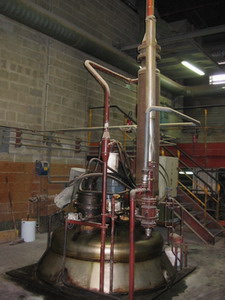Heating model
Heating operations are frequently used in process industry on various installations (such as reactors, vessel, etc.). The following photo presents a high temperature reactor.

VOC emissions during heating phase can be determined with this heating model, which gives good results when the temperature increase is significant and approaches the boiling point.
Example:
A 7.5 m3 reactor contains 5 m3 of a solvent mixture with the following composition (in mass fraction):
- Toluene : 60%,
- Méthyl isobutyl ketone : 30%,
- Methylene chloride : 10%.
The solvent mixture is heated from 20 to 70°C and the reactor is vented to atmosphere during the heat up operation.
Total emissions calculated during this heating operation are: 2.137 kg of VOC.
For each product emission is:
- Toluene : 0.615 kg,
- Méthyl isobutyl ketone : 0.227 kg,
- Methylene chloride : 1.294 kg.
References :
- Hatfield, Allen. Improved Algorithum for Estimating Process Emissions From Batch Heating, Environmental Progress, Vol. 17, No. 3, pp. 190-194. (Fall 1998)
- EIIP. 2005. Methods for Estimating Air Emissions from Paint, Ink and Other Coating Manufacturing Facilities Chapter 8 in EIIP Volume II.



